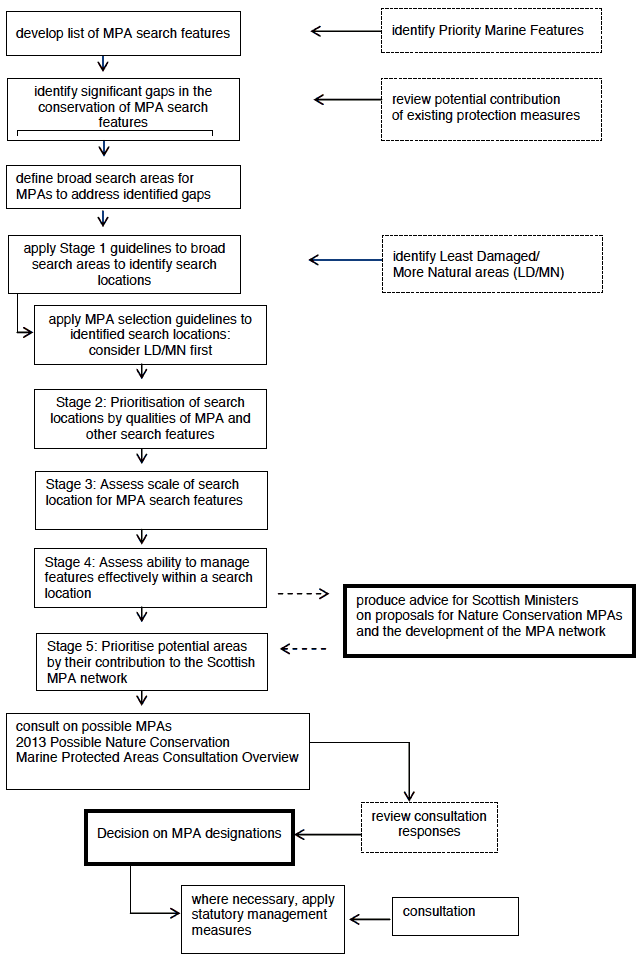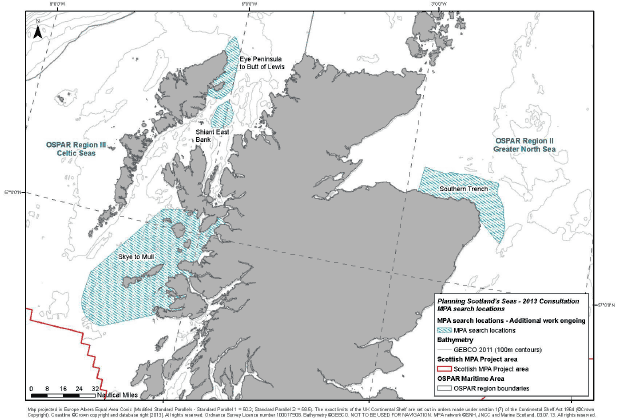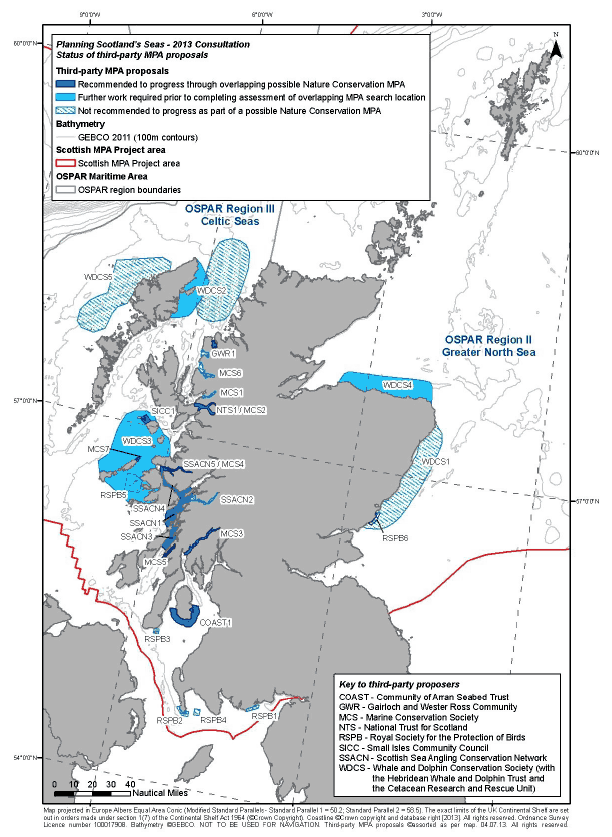Planning Scotland's Seas: 2013 - Possible Nature Conservation Marine Protected Areas Consultation Overview - Strategic Environmental Assessment Report
This report summarises the findings from a strategic environmental assessment (SEA) of the possible Marine Protected Areas (pMPAs).
4.0 Reasonable Alternatives
4.1 Figure 6 sets out the process for identifying and selecting possible MPAs. The purpose of this section is to set out the way in which reasonable alternatives have been identified and assessed in the course of this process.
4.2 The process has used a science-led approach. Science has been the primary consideration in the selection of sites. Socio-economic evidence will be considered when the ecological coherence of the network has been met. Ministers also have a power to take account of socio-economic impacts that may arise from a MPA designation.
4.3 The list of MPA search features is based on priority marine features( PMFs), identified on the basis of features identified and protected by the following conservation measures: the OSPAR Convention, Biodiversity Action Plans, the Scottish Biodiversity Strategy and the EC Habitats and Birds Directives. The MPA search features mostly comprise those PMFs for which MPAs are considered an appropriate conservation measure. Fish have been added to the list of MPA search features, as it was considered that these species were not adequately represented. [12]
4.4 The OSPAR criteria have been a key component of the process:
- Representation - To support the sustainable use, protection and conservation of marine biological diversity and ecosystems, areas which best represent the range of species, habitats and ecological processes (for which MPAs are a suitable measure) should be considered for inclusion.
- Replication - Replication of features in separate MPAs in each biogeographic area is desirable where it is possible in order to contribute to resilience and the aims of the network.
- Size of site - The appropriate size of a site should be determined by the purpose of the site and be sufficiently large to maintain the integrity of the feature for which it is selected.
- Adequacy - the MPA network should be of adequate size to deliver its ecological objectives.
- Connectivity - the MPA network should take into account the linkages between marine ecosystems and the dependence of species and habitats on processes that occur outside the MPA concerned.
- Management - MPAs should be managed to ensure the protection of the features for which they were selected and to support the functioning of an ecologically coherent network.
4.5 Key decisions have been undertaken all the way through the process described in Figure 6. These include:
- amendments to boundaries, e.g. drawing boundaries more tightly around features of interest; amending boundaries to reflect distribution of search features or black guillemot foraging activity, for example; amalgamating smaller areas to better represent areas to support features, e.g. common skate.
- changes to "drivers", e.g. the use of mud burrowing amphipod Maera loveni as a driver in identifying boundaries to the Norwegian boundary sediment plan pMPA was dropped, given the short longevity of the feature and the likelihood that it is under-recorded.
- requests for additional information to underpin pMPAs have resulted in additional survey and review work, which has informed the process ( e.g. work on fronts in support of the Clyde Sea Sill pMPA)
- removal of features from some pMPA proposals, e.g. burrowed mud, common skate from Loch Sunart pMPA; burrowed mud from Shiant East Bank; and sand eels from Fetlar to Haroldswick.
- the addition of features to some pMPAs, e.g. common skate to Loch Sunart to Sound of Jura pMPA; and geodiversity features to Small Isles pMPA.
- moving features from one pMPA to another, e.g. basking shark and minke whale from Small Isles and development of a new search location - Skye to Mull - for these.
4.6 Further details are provided in SNH/ JNCC's advice to the Scottish Government. Stakeholder engagement has been a key part of this aspect of the MPA process.
4.7 The SNH/ JNCC advice also contains details of alternative sites considered. For example, alternatives have been identified to some pMPAs to deal with the potential overlap with economic activities, e.g. Firth of Forth Banks Complex ( FOF) to deal with overlap between pMPA and offshore renewables; Central Fladen ( CFL) to deal with overlap between pMPA and Nephrops fishing grounds (see paragraphs 4.14-16 and 4.17-20 respectively).
4.8 There are also alternatives based around scientific alternatives and pMPAs which are considered to ecologically equivalent. These are described in paragraphs 4.21-22.
Figure 6. MPA identification and selection process

Alternative Approaches
Timing
4.9 It has been suggested that identification of a coherent ecological network should be delayed, at least until the assessment of the four search locations is complete. The challenge of taking forward the network in the light of existing gaps in the scientific evidence is acknowledged. However, it should be noted that an iterative approach (including refinement of the pMPAs) is a cornerstone of this work, and that the six-year review cycle will facilitate the continued collection of environmental data and activity information. It will also facilitate amendment of pMPA boundaries in response to pressures and changes resulting from both natural variability and human activities. In addition, such a delay would result in significant uncertainty for the marine economic sector. Scottish Ministers are of the view that this work should be progressed, noting that it has taken a precautionary stance.
Conservation Objectives
4.10 The focus of the possible MPAs is to either:
- protect a range of biodiversity or geodiversity features in their current state for the future, or
- to allow them to recover to the state they should be to remain healthy and productive.
4.11 An alternative to this approach would be to restore and/or enhance features. This possibility was reviewed in the early stages of the process. It was felt that there is insufficient clear evidence to support an objective to "restore". For example, changes to features are not always the result of anthropogenic pressures: natural processes, which are inherently variable ( e.g. in the weather) play a significant role in this. In addition, a "restore" objective would require information about the historic condition of a feature, and this evidence is rarely available. It was therefore decided to utilise the "conserve" and "recover" objectives, as appropriate and on a site-by-site basis, for each of the features.
Alternative Proposals
4.12 The alternative proposals include:
- the choices available for representation of certain features
- search locations
- third-party MPA proposals
Choices available for representation of certain features
4.13 For certain features there are options and alternatives to represent them in the network. The consultation seeks views on the following choices.
Science-based alternative: Offshore subtidal sands and gravels, ocean quahog and shelf banks and mounds in OSPAR Region II
4.14 JNCC identified science-based alternatives to the features being considered for protection within the Firth of Forth Banks Complex pMPA. Two pMPAs were identified to provide alternative representation of the features within Firth of Forth Banks Complex. JNCC identified Turbot Bank as a pMPA alternative for the representation of the offshore subtidal sands and gravels feature and shelf banks and mounds within OSPAR Region II in Scotland's seas. Norwegian Boundary Sediment Plain is considered to adequately represent an alternative for the representation of ocean quahog within OSPAR Region II in Scotland's seas. The alternative proposal (Turbot Bank and Norwegian Boundary Sediment Plain pMPAs) does meet the Guidelines for consideration as Nature Conservation MPAs as together these possible MPAs provide an adequate alternative for the representation of the features. However, the lesser evidence-base for the two alternatives, and the lack of diversity indicated on the basis of available evidence, has led to JNCC's conclusion that that alternative is of lower biodiversity and geodiversity conservation value than the Firth of Forth Banks Complex pMPA.
4.15 Therefore the following are the choices as to the representation of offshore subtidal sands and gravels, ocean quahog and shelf banks and mounds in OSPAR Region II:
1. Firth of Forth Banks Complex;
2. Turbot Bank and Norwegian Boundary Sedimentary Plain; or
3. Firth of Forth Banks Complex, Turbot Bank and Norwegian Boundary Sedimentary Plain.
4.16 Irrespective of decisions on alternative representation of offshore subtidal sands and gravels, ocean quahog, and shelf banks and mounds in OSPAR Region II, Turbot Bank remains a possible MPA recommended for the protection of sandeels.
Ecologically equivalent options: Burrowed mud in OSPAR Region II
4.17 JNCC identified science-based alternatives to the Central Fladen proposal for the representation of the burrowed mud search feature in the Fladen Grounds in OSPAR Region II. The Central Fladen proposal represents two component features of the burrowed mud habitat: seapens and burrowing megafauna, and the tall seapen ( Funiculina quadrangularis). Western Fladen and South-East Fladen options have been identified as science-based alternative proposals for the representation of the seapens and burrowing megafauna component only.
4.18 All three pMPAs for the seapens and burrowing megafauna component of burrowed mud habitat have been assessed and are considered to be of equivalent ecological value. The tall seapen component of the burrowed mud feature within the Central Fladen pMPA is the known location that adequately represents that component within the Fladen Grounds.
4.19 JNCC concluded that representation of the burrowed mud search feature in offshore waters in OSPAR Region II could be achieved by either taking forward the Central Fladen proposal in its entirety, or taking forward just the part of Central Fladen containing the tall seapens together with one of the two alternative locations for the seapens and burrowing megafauna component.
4.20 Therefore the following are the choices as to the representation of the burrowed mud feature in the Fladens:
1. Central Fladen pMPA only;
2. The tall sea-pen component of Central Fladen, plus Western Fladen; or
3. The tall sea-pen component of Central Fladen, plus South-East Fladen.
Ecologically equivalent options: offshore subtidal sands and gravels, offshore deep-sea muds, burrowed mud in OSPAR Regions III and V
4.21 In offshore waters JNCC identified pMPAs with the potential to make an equivalent contribution to the network for representation of features. Atlantic-influenced slope offshore subtidal sands and gravels, offshore deep sea mud, burrowed mud, and an area of the Hebridean continental slope at the northern extent of the range of these features in OSPAR Regions III and V could be represented by either the South-West Sula Sgeir and Hebridean slope or the Geikie slide and Hebridean slope.
4.22 Therefore the following are the choices as to the representation of the offshore subtidal sands and gravels, offshore deep sea mud, and burrowed mud in OSPAR Regions III and V:
1. South-West Sula Sgeir and Hebridean slope; or
2. Geikie slide and Hebridean slope
Search Locations
4.23 Four areas that have yet to be assessed fully against the Scottish MPA Selection Guidelines remain as MPA search locations ( Figure 2):
- Southern Trench;
- Eye Peninsula to Butt of Lewis;
- Shiant East Bank; and
- Skye to Mull.
4.24 This is to enable further work to be completed on one or more of the relevant MPA search features before SNH provides its formal advice to Scottish Ministers in 2014. The remaining work relates primarily to mobile species features including minke whale, Risso's dolphin and basking shark. The Southern Trench MPA search location also encompasses the burrowed mud feature.
4.25 Shiant East Bank has been identified for the shelf banks and mound feature and finer resolution seabed habitats. Survey work was carried out within the MPA search location in November 2011; however, further information is required before the detailed assessment against the Scottish MPA Selection Guidelines can be completed. This will include information on the habitats and species associated with the shelf bank and mound and also on the functional role that it plays within the North Minch. SNH will provide its formal advice on the Shiant East Bank MPA search location in 2014.
Work on cetaceans and basking sharks
4.26 In July 2012 SNH and the University of Exeter launched a basking shark tagging project, focused on the Skye to Mull MPA search location. The aim of the project is to understand more about the fine-scale use of the search location by these animals. Alongside this, habitat modelling is underway for basking sharks and the three cetacean MPA search features, minke whale, Risso's dolphin and white-beaked dolphin.
4.27 The aim of the habitat modelling is to help understand more about the importance of the Eye Peninsula to Butt of Lewis, Skye to Mull and Southern Trench MPA search locations. The focus in identifying these search locations was on areas considered to be essential to key life stages ( e.g. as nursery or feeding areas), based on the use of effort-corrected sightings data complemented by information on species behaviour/use of these areas. The habitat modelling will combine the sightings/tagging data with relevant environmental data to improve our understanding of what is driving the use of these areas by the different species. Following completion of this work, SNH will consider the results and provide advice to Scottish Ministers on whether these areas should be taken forward as nature conservation pMPAs.
Figure 7. MPA search locations

Third-Party Nature Conservation MPA Proposals
4.28 Twenty-seven proposals for third-party Nature Conservation MPAs were received (Figure 8; a detailed list is provided in Appendix 2). Many of these overlapped with search locations that had already been identified. Others were taken forward, as part of the overall process, and assessed using the Scottish MPA Selection Guidelines.
4.29 Twelve proposals met all the relevant guidelines, and have contributed to the development of eight possible nature conservation MPAs. Twelve proposals were not recommended for further consideration, as these could not meet the test of importance or were not considered to make a significant contribution to the network for the features for which they were proposed. The remaining three have had their assessment delayed / deferred to enable completion of further work by SNH in 2013.
Assessment of reasonable alternatives
4.30 Alternatives were identified during the MPA identification and selection process, both in terms of the approach utilised and in terms of alternative pMPAs. Alternatives were refined and decisions on the appropriate way forward were made throughout the process. In consequence, the 33 pMPAs identified in Table 2 are considered to be the reasonable alternatives that will achieve an ecologically coherent network. The SEA has therefore focused on assessing the pMPAs as they currently stand, as these are considered to be the reasonable alternatives. SEA of the search locations will be undertaken, as required, once further evaluation is complete.
Figure 8. Third-party MPA proposals

Contact
There is a problem
Thanks for your feedback